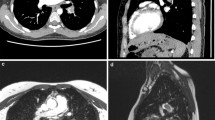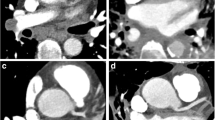Abstract
Tha aim of this study was to demonstrate the feasibility of MRI for short-term follow-up examinations in patients with acute pulmonary embolism (PE), and to assess temporal changes of pulmonary perfusion and thrombus characteristics that may be helpful in determining thrombus age. Thirty-three patients (15 female, 18 male, mean age 59.4 years) with acute PE were examined initially and 1 week later using both 16-row computed tomography (CT) and MRI with magnetic resonance angiography (MRA), real-time MRI and magnetic resonance (MR) pulmonary perfusion imaging. MRA and MR pulmonary perfusion used contrast-enhanced 3D flash sequences, and real-time MRI used true fast imaging with steady-state precession sequences (repetition time/echo time 3.1/1.5, bandwidth 975 Hz, 256 matrix size, acquisition time 0.4 s per image) in three orthogonal planes. Follow-up examinations were feasible for all patients. Diagnosis of PE was concordant between MRI and CT in all patients. The signal intensity of embolic material increased after 1 week for real-time MRI [132±5 vs. 232±22 (standard error of the mean), p<0.001], but not significantly for MRA. MR pulmonary perfusion of areas affected by PE increased (area under the curve initially 9.6±7.4, at follow-up 40.7±7.6, p<0.001). A decreasing time-to-peak in normal lung areas (15.7±0.96 and 13.2±0.55, respectively, p<0.05) indicated systemic circulatory effects of PE, and subsiding pulmonary artery obstruction improved arterial inflow for the entire lung. Follow-up examinations of patients with acute PE are feasible with MRI, and a relation between thrombus appearance and thrombus age can be implied.




Similar content being viewed by others
References
Schibany N, Fleischmann D, Thallinger C et al (2001) Equipment availability and diagnostic strategies for suspected pulmonary embolism in Austria. Eur Radiol 11:2287–2294
Meaney JF, Weg JG, Chenevert TL, StaffordJohnson D, Hamilton BH, Prince MR (1997) Diagnosis of pulmonary embolism with magnetic resonance angiography. N Engl J Med 336:1422–1427
Gupta A, Frazer CK, Ferguson JM et al (1999) Acute pulmonary embolism: diagnosis with MR angiography. Radiology 210:353–359
Reittner P, Coxson HO, Nakano Y et al (2001) Pulmonary embolism: comparison of gadolinium-enhanced MR angiography with contrast-enhanced spiral Ct in a porcine model. Acad Radiol 8:343–350
Oudkerk M, van Beek EJ, Wielopolski P et al (2002) Comparison of contrast-enhanced magnetic resonance angiography and conventional pulmonary angiography for the diagnosis of pulmonary embolism: a prospective study. Lancet 359:1643–1647
Van Beek EJ, Wild JM, Fink C, Moody AR, Kauczor HU, Oudkerk M (2003) MRI for the diagnosis of pulmonary embolism. J Magn Reson Imaging 18:627–640
Amundsen T, Kvaerness J, Jones RA et al (1997) Pulmonary embolism: detection with MR perfusion imaging of lung—a feasibility study. Radiology 203:181–185
Matsuoka S, Uchiyama K, Shima H et al (2001) Detectability of pulmonary perfusion defect and influence of breath holding on contrast-enhanced thick-slice 2d and on 3d MR pulmonary perfusion images. J Magn Reson Imaging 14:580–585
Amundsen T, Torheim G, Kvistad KA et al (2002) Perfusion abnormalities in pulmonary embolism studied with perfusion mri and ventilation-perfusion scintigraphy: an intra-modality and inter-modality agreement study. J Magn Reson Imaging 15:386–394
Ohno Y, Higashino T, Takenaka D et al (2004) Mr angiography with sensitivity encoding (sense) for suspected pulmonary embolism: comparison with mdct and ventilation-perfusion scintigraphy. Am J Roentgenol 183:91–98
Kluge A, Mueller C, Hansel J, Gerriets T, Bachmann G (2004) Real time MR with Truefisp for the detection of acute pulmonary embolism: initial clinical experience. Eur Radiol 14:709–718
Haage P, Piroth W, Krombach G et al (2003) Pulmonary embolism: comparison of angiography with spiral computed tomography, magnetic resonance angiography, and real-time magnetic resonance imaging. Am J Respir Crit Care Med 167:729–34
Remy-Jardin M, Louvegny S, Remy J et al (1997) Acute central thromboembolic disease: posttherapeutic follow-up with spiral CT angiography. Radiology 203:173–180
Mastora I, Remy-Jardin M, Masson P et al (2003) Severity of acute pulmonary embolism: evaluation of a new spiral CT angiographic score in correlation with echocardiographic data. Eur Radiol 13:29–35
Kluge A, Dill T, Ekinci O et al (2004) Decreased pulmonary perfusion in pulmonary vein stenosis after radio-frequency ablation: assessment with dynamic MR perfusion imaging. Chest 126:428–437
Diederich S (2003) Radiation dose in helical CT for detection of pulmonary embolism. Eur Radiol 13:1491–1493
Fuchs F, Laub G, Othomo K (2003) Truefisp—technical considerations and cardiovascular applications. Eur J Radiol 46:28–32
Wagenvoort CA (1995) Pathology of pulmonary thromboembolism. Chest 107:10S–17S
Qanadli SD, El Hajjam M, Vieillard-Baron A et al (2001) New CT index to quantify arterial obstruction in pulmonary embolism: comparison with angiographic index and echocardiography. Am J Roentgenol 176:1415–1420
Author information
Authors and Affiliations
Corresponding author
Rights and permissions
About this article
Cite this article
Kluge, A., Gerriets, T., Lange, U. et al. MRI for short-term follow-up of acute pulmonary embolism. Assessment of thrombus appearance and pulmonary perfusion: a feasibility study. Eur Radiol 15, 1969–1977 (2005). https://doi.org/10.1007/s00330-005-2760-7
Received:
Revised:
Accepted:
Published:
Issue Date:
DOI: https://doi.org/10.1007/s00330-005-2760-7




